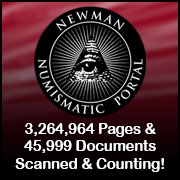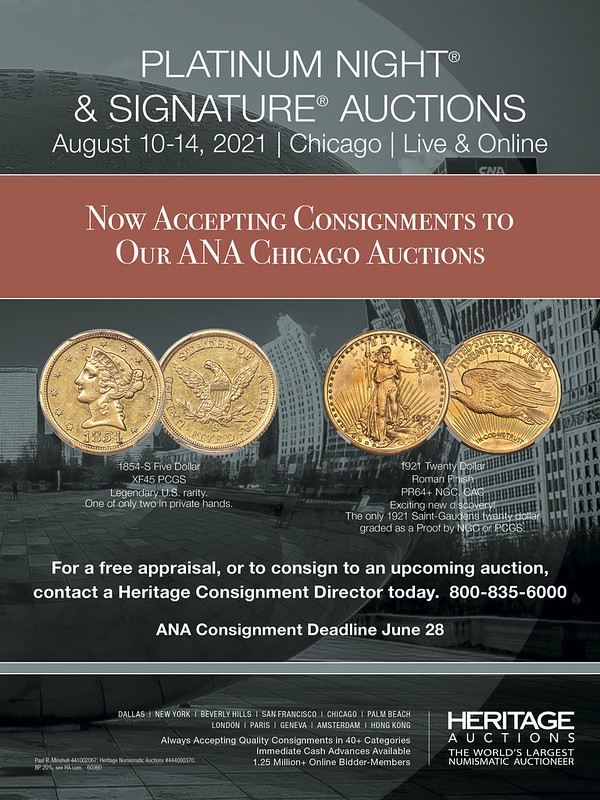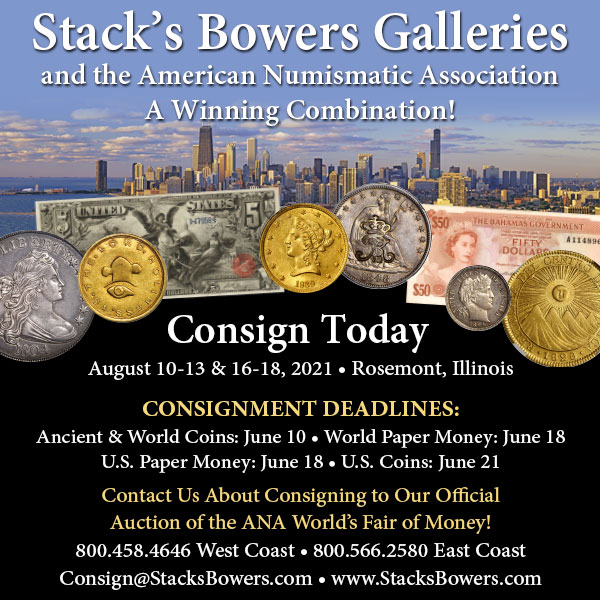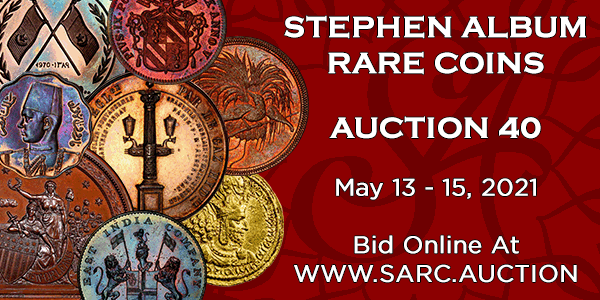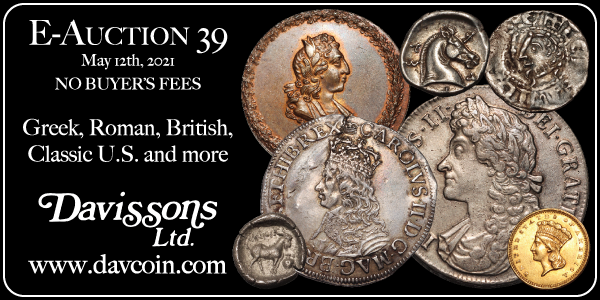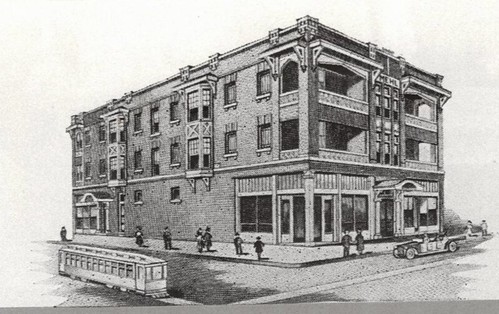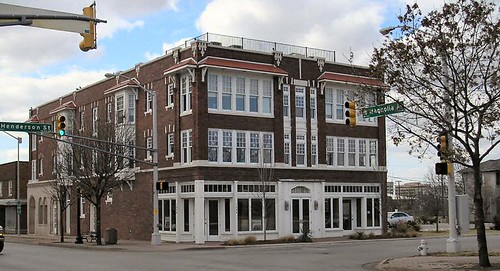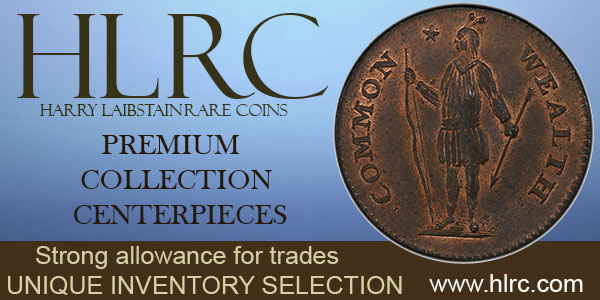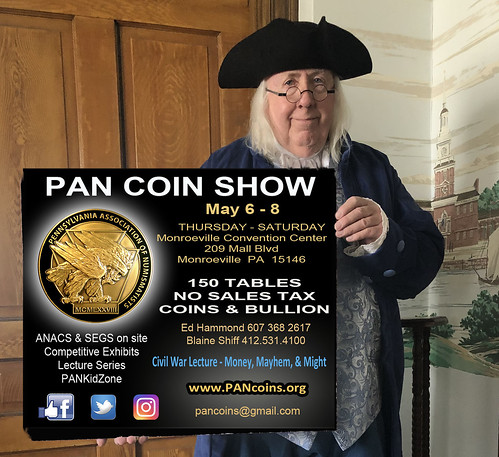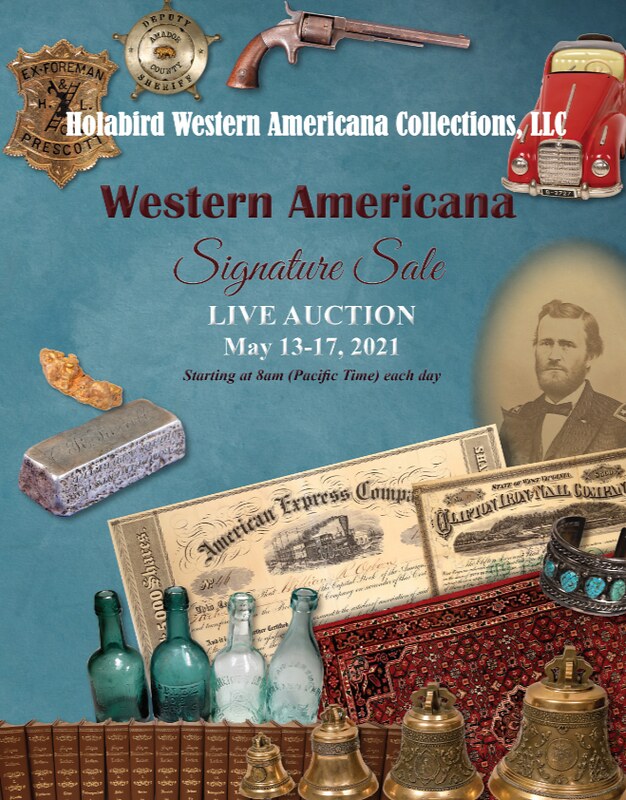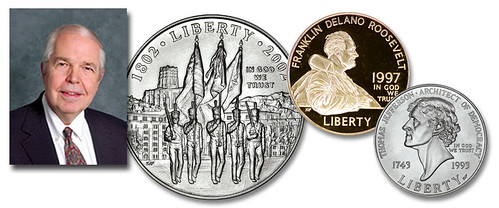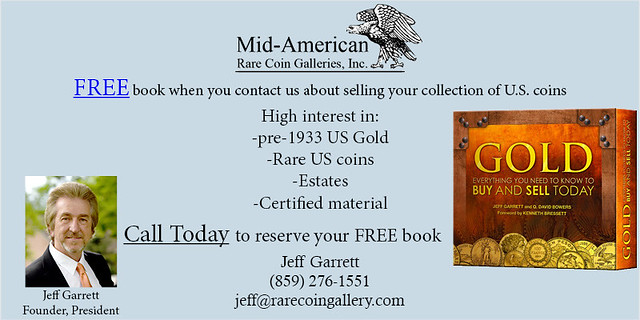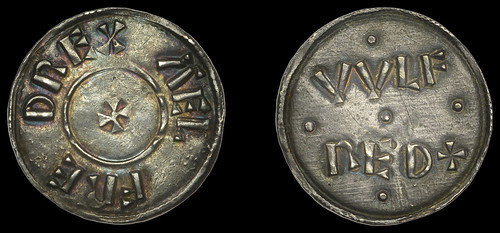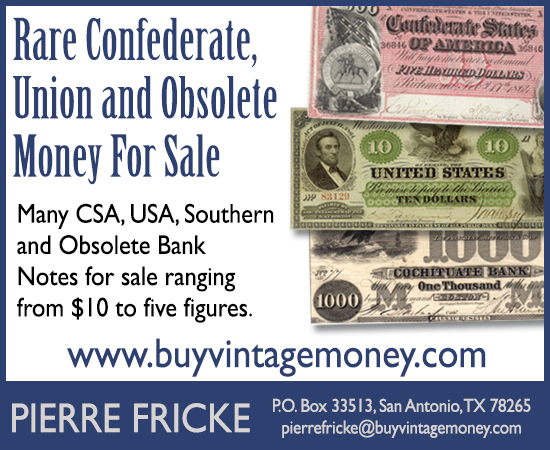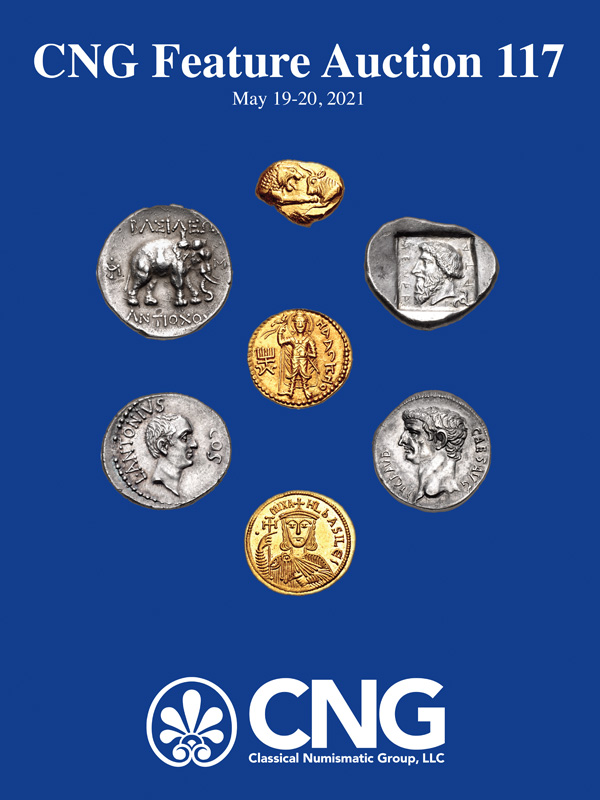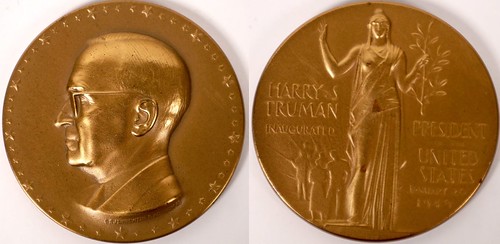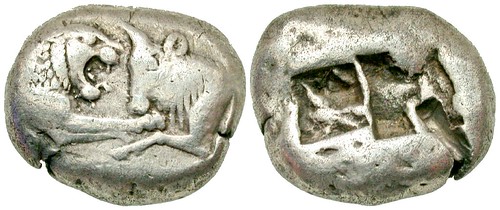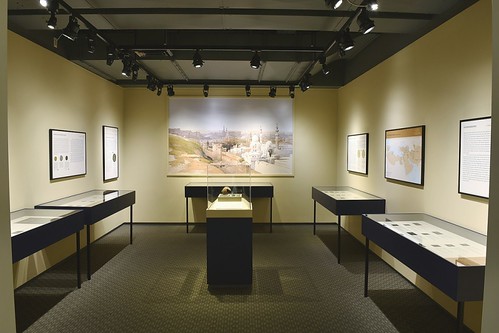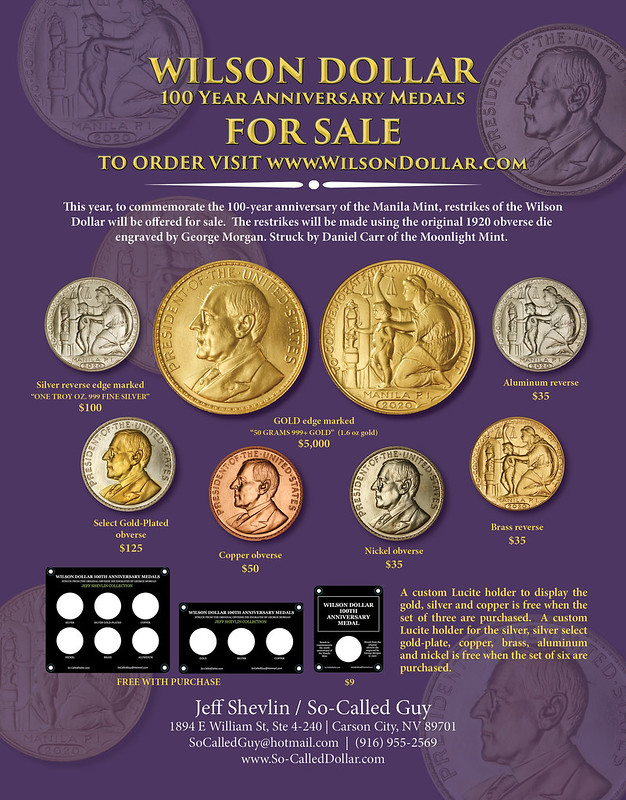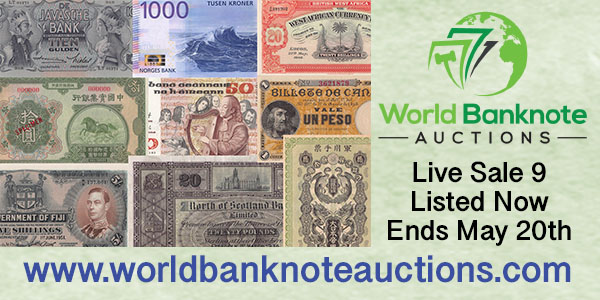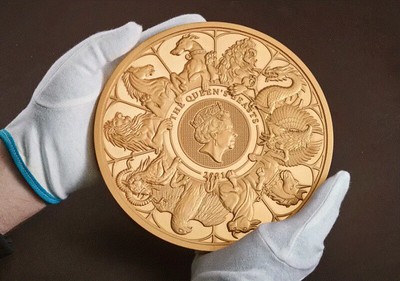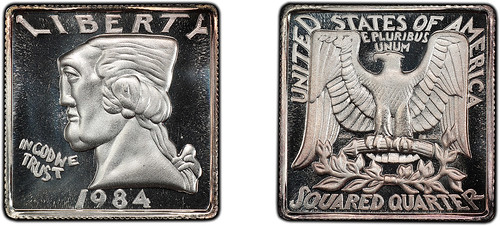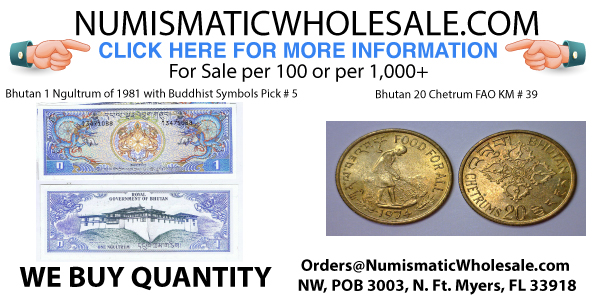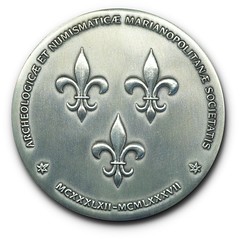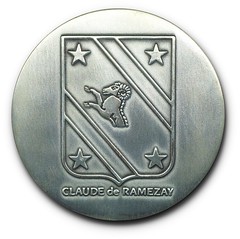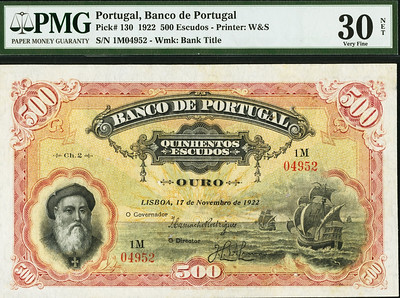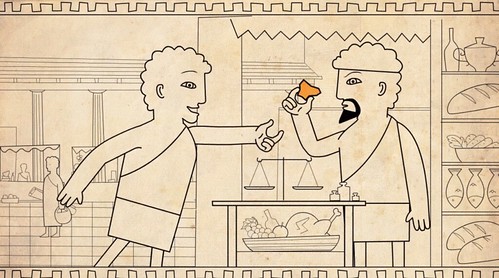
Visit our NBS Sponsors


|
About Us
The Numismatic Bibliomania Society is a non-profit association devoted to the study and enjoyment of numismatic literature. For more information please see our web site at coinbooks.org SubscriptionsThose wishing to become new E-Sylum subscribers (or wishing to Unsubscribe) can go to the following web page link MembershipThere is a membership application available on the web site Membership Application To join, print the application and return it with your check to the address printed on the application. Print/Digital membership is $40 to addresses in the U.S., and $60 elsewhere. A digital-only membership is available for $25. For those without web access, write to: Charles Heck, Treasurer AsylumFor Asylum mailing address changes and other membership questions, contact Chuck at this email address: treasurer@coinbooks.org SubmissionsTo submit items for publication in The E-Sylum, write to the Editor at this address: whomren@gmail.com BUY THE BOOK BEFORE THE COIN |
- WAYNE'S WORDS: THE E-SYLUM MAY 2, 2021
- KOLBE & FANNING AUCTION SALE 160 ANNOUNCED
- NEW BOOK: THE GOLD SOVEREIGN SERIES
- NEW BOOK: MAGIC TOKENS
- NEW BOOK: THE GERMAN BANKNOTES FROM 1871
- NEW BOOK: SECURITY FEATURES OF BANKNOTES
- R.S. YEOMAN AND HIS REMARKABLE RED BOOK
- EARLY PAPER MONEY OF AMERICA ON NNP
- VIDEO: COOL COINS AT COLLECTORAMA 2021
- MORE ON MEHL'S NUMISMATIC BANK BUILDING
- ON INFLUENCE IN NUMISMATICS
- ANSWER: "I.G." ON MARYLAND COLONIAL NOTE
- NOTES FROM E-SYLUM READERS: MAY 2, 2021
- MORE ON THE MONNERON 2 SOL PATTERN PIECE
- QUERY: SHAGIN JOHNSON MATTHEY SILVER ROUNDS
- VOCABULARY TERM: DRAWINGS AND SKETCHES
- SAMUEL BIRCHALL (1761-1814)
- DAVID ULYSSES PROSKEY (1853-1928)
- MINT ENGRAVER T. JAMES FERRELL
- DENNIS TUCKER NOW A KENTUCKY COLONEL
- DNW OFFERS SAMUEL BIRCHALL COLLECTION
- ON CONDITION, DAMAGE, AND PRICE
- MODERN RARE COINS IN ALBUM AUCTION 40
- SELECTIONS FROM HOLABIRD MAY 2021 SALES
- NUMISMATIC NUGGETS: MAY 2, 2021
- AULERCI CENOMANI GOLD STATER FOUND IN JERSEY
- LEISER COLLECTION OF MEDIEVAL ISLAMIC COINS
- IRON AGE COINS IN BRITAIN
- QUEEN'S BEASTS GOLD 10-KILO £10,000 COIN
- THE ANDOR ORAND SQUARED QUARTER
- NUMISMATIC SOCIETY OF MONTREAL MEDALS
- BAUMAN COLLECTION OF CHEMICAL CURRENCY
- 1922 BANK OF PORTUGAL 500 ESCUDOS NOTE
- SCRIPOMANIA AND THE MADNESS FOR SPECULATION
- LOOSE CHANGE: MAY 2, 2021
- THE COIN AND CURRENCY CLUB
Click here to read the thin version on the web
Click here to subscribe
Click here to access the complete archive
To comment or submit articles, reply to whomren@gmail.com
Content presented in The E-Sylum is not necessarily researched or independently fact-checked, and views expressed do not necessarily represent those of the Numismatic Bibliomania Society.
WAYNE'S WORDS: THE E-SYLUM MAY 2, 2021
 New subscribers this week include:
Mike Nixon.
Welcome aboard! We now have 6,641 subscribers.
New subscribers this week include:
Mike Nixon.
Welcome aboard! We now have 6,641 subscribers.
Thank you for reading The E-Sylum. If you enjoy it, please send me the email addresses of friends you think may enjoy it as well and I'll send them a subscription. Contact me at whomren@gmail.com anytime regarding your subscription, or questions, comments or suggestions about our content.
This week we open with a new Kolbe & Fanning numismatic literature sale, four new books, updates from the Newman Numismatic Portal, Mehl's "Numismatic Bank" building, and more.
Other topics this week include Ken Bressett, Johnson Matthey silver rounds, dealer David Proskey, engraver T. James Ferrell, Col. Dennis Tucker, modern rare coins, auction previews, the Queen's Beasts, the squared quarter, and scripomania.
To learn more about the Treasure of Via Alesandrina, magic tokens, German banknotes, banknote security features, the marbled edge $20 Continental Currency issue, the Holiest Coin Collection, the Samuel Birchall collection, Iron Age Coins in Britain, the Pedley Ryan dollar, the 1848 CAL. Quarter Eagle, the Antiquarian and Numismatic Society of Montreal, chemical currency, and "Britcoins", read on. Have a great week, everyone!
Wayne Homren
Editor, The E-Sylum
THE BOOK BAZARRE
KOLBE & FANNING AUCTION SALE 160 ANNOUNCED
Kolbe & Fanning have announced their next numismatic literature sale. Some great material here. -Editor
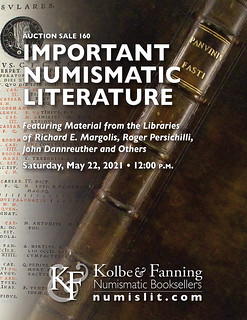 Kolbe & Fanning May 22 Book Auction
Kolbe & Fanning May 22 Book Auction
Kolbe & Fanning Numismatic Booksellers are announcing our Sale 160, which will be held on Saturday, May 22, 2021. The 459-lot sale features additional material from the library of Richard Margolis, along with selections from Roger Persichilli, John Dannreuther, and the TAB Library. The sale includes books, catalogues and other publications on a variety of numismatic topics, including standard current works, antiquarian volumes, rare plated catalogues, and much else.
Some highlights of the sale include:
NEW BOOK: THE GOLD SOVEREIGN SERIES
Token Publishing, Publishers of Coin News and Medal News, have announced a new edition of their book on the gold sovereign coinage. -Editor
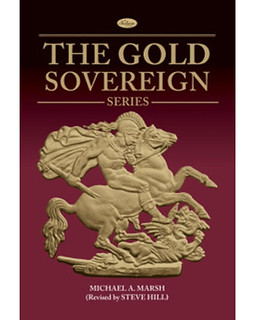 The first revised edition of the Token Publishing Ltd imprint of Michael Marsh's The Gold Sovereign was published in 2017 to coincide with the 200th anniversary year of the famous coin. Since then this book, fully revised and updated by Steve Hill of Sovereign Rarities (formerly of Spink and Baldwins) has become the reference work on the sovereign, half sovereign and quarter sovereign.
The first revised edition of the Token Publishing Ltd imprint of Michael Marsh's The Gold Sovereign was published in 2017 to coincide with the 200th anniversary year of the famous coin. Since then this book, fully revised and updated by Steve Hill of Sovereign Rarities (formerly of Spink and Baldwins) has become the reference work on the sovereign, half sovereign and quarter sovereign.
The new edition, now entitled The Gold Sovereign Series, is available NOW, and once again it has been updated by Steve with all new sovereigns and fractionals issued since 2017 added, Also, for the very first time, the five sovereign and two sovereign coins are included too, all in one hardbound, profusely illustrated 272-page volume, making this the absolutely definitive work on the iconic series. This long-awaited second edition is available to order today priced at £39.95 (post-free if ordered before midnight on May 3) and comes complete with an accompanying price and rarity guide.
NEW BOOK: MAGIC TOKENS
We recently discussed an unusual Whitehead & Hoag token that some speculated was a magician's piece. John Mutch recently learned about a recent book on the topic from a Facebook post. I don't believe we've discussed this one before. First here's the background from the FB Topmagician1 feed (September 14, 2018). -Editor
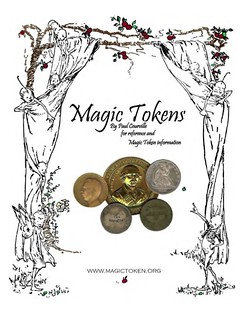 This note is being sent out to all collectors of magic, and specifically magic tokens, that we know about. Over the past few years, Paul Courville has been working with Robert A. Olson on an update of the noted book Magic Tokens and Related Items, by F. William Kuethe. This was published by the Token and Medal Society in 1978 and listed over 400 tokens (now simply called Magic Tokens). Today, that number of known tokens has more than doubled. When Robert A. Olson told Kuethe about it, and shared Courville's website with him, Kuethe's response was, "If there is anything that I can do to help, please let me know". The book will be available on line by going to
http://www.magictoken.org/ (then click on THE MAGIC TOKEN GUIDE button).
This note is being sent out to all collectors of magic, and specifically magic tokens, that we know about. Over the past few years, Paul Courville has been working with Robert A. Olson on an update of the noted book Magic Tokens and Related Items, by F. William Kuethe. This was published by the Token and Medal Society in 1978 and listed over 400 tokens (now simply called Magic Tokens). Today, that number of known tokens has more than doubled. When Robert A. Olson told Kuethe about it, and shared Courville's website with him, Kuethe's response was, "If there is anything that I can do to help, please let me know". The book will be available on line by going to
http://www.magictoken.org/ (then click on THE MAGIC TOKEN GUIDE button).
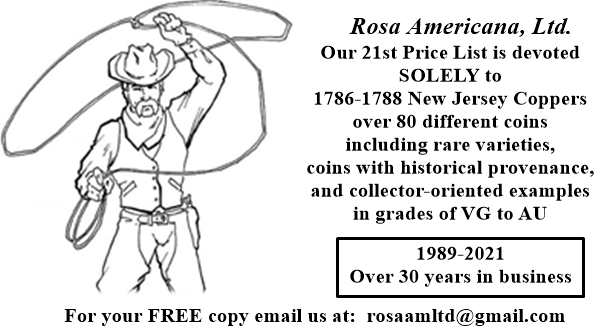
NEW BOOK: THE GERMAN BANKNOTES FROM 1871
OK, here's another new edition of a numismatic book written in German. But I think we're safe translating this title to English. It's a book on German banknotes from 1871 onward. Here's a Google-translated description from the publisher's website. -Editor
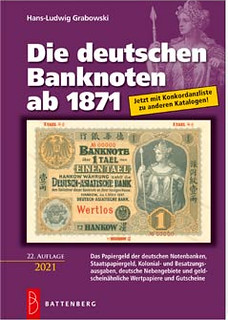 The German banknotes from 1871
The German banknotes from 1871
by Hans-Ludwig Grabowski
The paper money of the German central banks, government paper money, colonial and occupation expenses, German secondary areas and banknote-like securities and vouchers
Published by Battenberg Verlag
ISBN: 978-3-86646-183-3
Edition: 22nd edition 2020
Images: colored throughout
Hardcover: 928 pages
Format: 14.8 x 21 cm
NEW BOOK: SECURITY FEATURES OF BANKNOTES
Roland Rollins has published a new book on security features of modern banknotes. -Editor
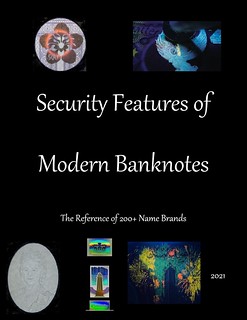 There are 7 chapters covering generic security features and over 200 trade name security features, 90% with image examples. Chapters include
There are 7 chapters covering generic security features and over 200 trade name security features, 90% with image examples. Chapters include
- Printing Methods
- Watermarks and Windows
- Inks
- Security Strips
- Security Mask
- Foil, & Patch
- Substrates
- Varnishes & Coatings
The book runs 69 pages.
R.S. YEOMAN AND HIS REMARKABLE RED BOOK
Dennis Tucker of Whitman Publishing penned this article with additional information on R.S. Yeoman and the new book about the Red Book founding editor. -Editor
A Penny Saved: R.S. Yeoman and His Remarkable Red Book, the latest Whitman Publishing book by Kenneth Bressett, debuts in summer 2021 to celebrate the 75th anniversary of Yeoman's Guide Book of United States Coins (the "Red Book"). The 352-page hardcover volume will be available from bookstores and hobby shops and online (including at Whitman.com), and in the meantime is available for preorder. Here, Whitman publisher Dennis Tucker describes the process of how A Penny Saved came to be, and why it was undertaken in the first place.
Celebrating R.S. Yeoman and His Remarkable Red Book
How and Why We Commemorate the Red Book's 75 Years
EARLY PAPER MONEY OF AMERICA ON NNP
Newman Numismatic Portal Project Coordinator Len Augsburger provided this report on the latest updates to Newman's Early Paper Money of America. Thanks. -Editor
Early Paper Money of America on Newman Portal
We continue to update the NNP Edition of Eric Newman's Early Paper Money of America. This online version incorporates additional images from the Newman paper money sales, in addition to edits contributed by collectors and researchers. Ray Williams, David Gladfelter, and others have contributed to this ongoing effort.
VIDEO: COOL COINS AT COLLECTORAMA 2021
These are selections from the David Lisot Video Library that feature news and personalities from the world of coin collecting. David has been attending coin conventions since 1972 and began videotaping in 1985. The Newman Numismatic Portal now lists all David's videos on their website at:
https://nnp.wustl.edu/library/multimediadetail/522852
Here's another one from the recent Collectorama show, highlighting several of the interesting coins offered there. -Editor
Cool Coins at Collectorama 2021!
VIDEO: 8:27.
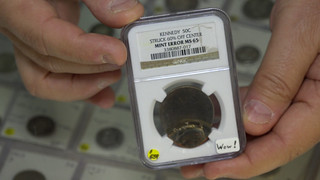 David Lisot, Interviewer, CoinTelevision.com with Edward Kuszmar, John Maben, Owner, Pegasus Coin & Jewelry, Rick & Patricia DeSanctis, Numismatic Classics.
David Lisot, Interviewer, CoinTelevision.com with Edward Kuszmar, John Maben, Owner, Pegasus Coin & Jewelry, Rick & Patricia DeSanctis, Numismatic Classics.
Cool coins can be almost any coins. Hear and see interesting concepts of coolness for coins that include the American Eagle gold 1/10 ounce uncirculated, an off-center Kennedy Half Dollar, multiple one ounce copper uncirculated rounds, and an 1882-CC GSA Toned Silver Dollar NGC MS65.
An excerpt of the video is available for viewing on the Coin Television YouTube Channel at:
https://youtu.be/gPwKlObkV4U
MORE ON MEHL'S NUMISMATIC BANK BUILDING
Dave Lange writes:
"Peter Huntoon grieved over alterations to B. Max Mehl's Numismatic Bank building, but for a structure that old it has retained most of its original character. The only obvious alteration is enclosure of the open balconies.
I visited the Mehl Building in 2003 while it was being renovated, but I don't have my photos of that trip handy. Attached are some shots from five years later, when the work was completed. These were taken while the leaves were off the trees, so they provide a better view of its details."
ON INFLUENCE IN NUMISMATICS
American Numismatic Biographies author Pete Smith submitted this op-ed style item about criteria defining influence in the world of numismatics. -Editor
Influential Numismatists
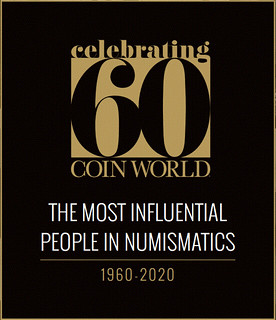 Last October I reviewed the list of about two hundred people under consideration by Coin World for their
list of The Most Influential People in Numismatics. I added more than fifty names to my listing of
American Numismatic Biographies (ANB) although I thought some of them were weak candidates.
Last October I reviewed the list of about two hundred people under consideration by Coin World for their
list of The Most Influential People in Numismatics. I added more than fifty names to my listing of
American Numismatic Biographies (ANB) although I thought some of them were weak candidates.
Last Wednesday I received the issue with the 96 people selected. I went through the statements and made about 400 revisions to ANB based on those statements. There were a couple of names I did not recognize and about five people who were not already in ANB. I will not be adding them.
There are people on the list who have never written a book, never had an article published, never held an office in a coin club, never made an educational presentation at the ANA and never received an award from a numismatic organization.
ANSWER: "I.G." ON MARYLAND COLONIAL NOTE
Regarding last week's reader question about the notation "1 G" on an April 10, 1774 Maryland 2/9 of a dollar colonial note Paul Horner writes:
"I do not think "1 G." is a denomination. I believe it may be the engravers initials: I G and not 1 (one) G.
"Newman says these were printed by Anne Catherine Green and Frederick Green. Perhaps "I G." was a son or relative that engraved the plates.
"OR: is "G" an obscure abbreviation for shilling? "1 G." would work if that was the case. If it is, I can find no reference to it."
NOTES FROM E-SYLUM READERS: MAY 2, 2021
Copper 1794 Dollar Pattern SalesDave Hirt writes:
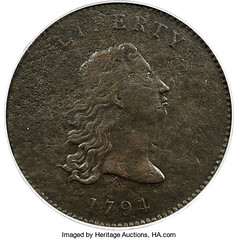 "Another great issue as always. The news of the sale of the 1794 no stars pattern dollar was quite interesting to me. $840,000! The Pollock book of US Patterns lists the previous sale of that coin in 1989 as $21,000. Wow, what a way to invest your money, as well as pride of ownership of a unique coin. The consigner had to be all smiles!
"Another great issue as always. The news of the sale of the 1794 no stars pattern dollar was quite interesting to me. $840,000! The Pollock book of US Patterns lists the previous sale of that coin in 1989 as $21,000. Wow, what a way to invest your money, as well as pride of ownership of a unique coin. The consigner had to be all smiles!
"I was looking at the list of the former owners of the coin. It seemed curious to me that in 1890 it changed hands two times within six months, both times by the same company, New York Stamp and Coin. I pulled my catalog of the R. Coulton Davis sale, Jan. 1890. The obv. of the coin is plated on plate 3, but the plate is rather dark. David Proskey described the coin as "good for the period, unique." The coin realized $35. The buyer's name is listed as Lelay. I do not recognize that name. It may be in code. Just thinking, perhaps Parmelee was not the buyer, but another who returned the coin to NY because of condition. Then Proskey put the coin in the Parmelee sale in June 1890. He changed his description a bit to say "planchet not smooth." , which is consistent with the Heritage description as "excavated at the mint." The coin realized $20 in the Parmelee sale."
Thanks! It's always interesting to trace the provenance of a coin and see whose hands it passed through over the years. Does "Lelay" ring a bell for anyone? I've come up empty in the Newman Portal. -Editor
To read the earlier E-Sylum article, see:
COPPER 1794 DOLLAR PATTERN PUBLICITY
(https://www.coinbooks.org/v24/esylum_v24n17a24.html)
Other topics this week include Limited Edition Red Books, Bill McKivor, holed coins, and an unusual Mott token. -Editor
MORE ON THE MONNERON 2 SOL PATTERN PIECE
Two weeks ago Jim Duncan asked,
"Can any of your many contacts provide a reproducible pic of a Monneron 2 Sol pattern piece (that's Hercules / Pyramid)? I'm a collector in NZ who cannot find one on the web..."
I didn't manage to compile responses until now, but Ken Spindler was able to provide an image and much more. Thanks! Here's Ken's response. -Editor
QUERY: SHAGIN JOHNSON MATTHEY SILVER ROUNDS
Christopher Fleming has a question about Johnson Matthey silver rounds. I can't help, but perhaps one of our readers can. -Editor
 Greg Burns from The California Numismatist sent me your way to ask a question that I have. I have just recently acquired three Johnson Matthey one ounce .999 silver rounds minted in 1986 from what looks to be the "Liberty Series Centennial Anniversary of the Statue of Liberty" plaque that the Ellis Island Foundation had commissioned sculptor Alex Shagin to do. I have never seen these bullion rounds before and I was hoping maybe you had some information about them.
Greg Burns from The California Numismatist sent me your way to ask a question that I have. I have just recently acquired three Johnson Matthey one ounce .999 silver rounds minted in 1986 from what looks to be the "Liberty Series Centennial Anniversary of the Statue of Liberty" plaque that the Ellis Island Foundation had commissioned sculptor Alex Shagin to do. I have never seen these bullion rounds before and I was hoping maybe you had some information about them.
I have found a few articles on Alex Shagin and the plaque he had done and discovered it is featured on the cover of "The California Numismatist" winter 2008 edition. I have seen plenty of other types of Johnson Mathey Liberty rounds and bars and thanks to Allengelhard.com estimated mintages and other information, however, I cannot find anything about these rounds.
If you have any information about JM working with Mr. Shagin, estimated mintage numbers for this round, etc. It would be greatly appreciated.
VOCABULARY TERM: DRAWINGS AND SKETCHES
Here's another entry from Dick Johnson's Encyclopedia of Coin and Medal Terminology. -Editor
Drawings and Sketches. The earliest concepts of a design recorded in some way as a plan to be developed further. The first ideas of a numismatic or medallic design are usually in the two-dimensional form of a drawing before the design is rendered into a three-dimensional form, either of which is called a study. Often a great number of drawings are made (if small and sketchy they are called thumbnail drawings); the artist will proceed until a concept for the design is chosen. The process in the mind of the artist is often one of trial and selection, with those having merit being recorded in a drawing, and others discarded.
SAMUEL BIRCHALL (1761-1814)
Here's a biography of early British coin collector and numismatic author Samuel Birchall by Peter Preston-Morley of Dix Noonan Webb. See an article elsewhere in this issue to learn more about DNW's upcoming sale of Birchall's 240-year old collection. -Editor
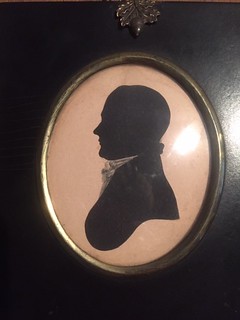 Samuel Birchall, one of five children of Caleb Birchall (1735-1805), of Rainford, Lancashire, and his wife Mary, née Stapleton (1739-1802), was born into a Quaker family in Horsehay, Shropshire, on 31 May 1761. He was a pupil of George Bewley's school in Kendal from 1773 to about 1777. The family moved to Stockport, Cheshire, in the summer of 1779, where his parents ran a calico and tea business. He married Anna Jowitt (1765-93) on 6 June 1785 and the following year moved to Leeds, where he joined his wife's family firm, John & Joseph Jowitt, woolstaplers, in which Samuel had become a partner by June 1788. Samuel occupied himself with civic duties in his newly-adopted home town. He served on the board of governors of Ackworth School and of the Infirmary, was a collector of rates, taxes and duties for the south Division of Leeds and was a trustee of the Workhouse.
Samuel Birchall, one of five children of Caleb Birchall (1735-1805), of Rainford, Lancashire, and his wife Mary, née Stapleton (1739-1802), was born into a Quaker family in Horsehay, Shropshire, on 31 May 1761. He was a pupil of George Bewley's school in Kendal from 1773 to about 1777. The family moved to Stockport, Cheshire, in the summer of 1779, where his parents ran a calico and tea business. He married Anna Jowitt (1765-93) on 6 June 1785 and the following year moved to Leeds, where he joined his wife's family firm, John & Joseph Jowitt, woolstaplers, in which Samuel had become a partner by June 1788. Samuel occupied himself with civic duties in his newly-adopted home town. He served on the board of governors of Ackworth School and of the Infirmary, was a collector of rates, taxes and duties for the south Division of Leeds and was a trustee of the Workhouse.
DAVID ULYSSES PROSKEY (1853-1928)
Here's another entry from the online draft of John Lupia's book of numismatic biographies. Thanks! This is an excerpt with the full article and bibliography available online. This week's subject is dealer David Proskey. -Editor
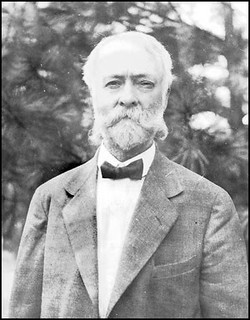 David Ulysses Proskey (1853-1928), was born the eldest of eight children, and first of five sons, on December 12, 1853, son of Sigismond Proskey (1837-1898), a Pollock and prosperous merchant by trade, and his mother born in Glasgow, Scotland of Irish parents, Anna "Jane" Josephine Lynch Proskey (1836-1898), at Wappinger Falls, Duchess County, New York. His father seems to have been educated in classics since he names his son Alexander and David's middle name is Ulysses.
David Ulysses Proskey (1853-1928), was born the eldest of eight children, and first of five sons, on December 12, 1853, son of Sigismond Proskey (1837-1898), a Pollock and prosperous merchant by trade, and his mother born in Glasgow, Scotland of Irish parents, Anna "Jane" Josephine Lynch Proskey (1836-1898), at Wappinger Falls, Duchess County, New York. His father seems to have been educated in classics since he names his son Alexander and David's middle name is Ulysses.
David Proskey is a very interesting personality in American numismatic history. Coming from a large family of industrious businessmen he had his hand in several prospects at any given time. His is a story of a young man whose hobby brought him fame and fortune over time. In the beginning he was probably involved in the Proskey Brothers mainly as an investor when his brother Alexander began a lumber business in Paterson, New Jersey, also the site where they lived. The Proskey Brothers soon became a building company, hoteliers, and then real estate brokers making many transactions over the years and a substantial fortune for the family. But, in the beginning David soon spread out to New York with an office selling stamps, coins, minerals, curios, and other antiquities. Keeping his own office he put his younger brother Samuel there after he had graduated from school during the day when he went off to work for John Walter Scott. In the evenings both would travel back home by train. Proskey probably edited Scott's Coin Collector's Journal from his own business office on many occasions but also appears to have had other duties managing the coin and medal department for Scott requiring his presence there.
MINT ENGRAVER T. JAMES FERRELL
Dave Bowers published a nice Stack's Bowers blog article this week on Mint Engraver T. James Ferrell. That's Dave's portrait below, not that of Ferrell. -Editor
Born in Clayton, New Jersey in 1939, T. James Ferrell graduated from the Pennsylvania Academy of Fine Arts, where he pursued studies in painting, sculpture, and graphics. Upon leaving art school in 1963, he worked as an artist on the staff of the Philadelphia Evening Bulletin for six years. In the decade after his graduation he served as monitor of the Professional Artists' Graphic Workshop at the Academy. He studied art at the Barnes Foundation in Merion, Pennsylvania for two years.
Ferrell is a recipient of the Cresson European Traveling Scholarship, the Charles Toppan Prize for oil painting, and for four consecutive years the Lux prize and the Woodrow prize in printmaking. Many institutions and galleries have exhibited his work.
DENNIS TUCKER NOW A KENTUCKY COLONEL
Congratulations to Whitman Publisher Dennis Tucker on becoming a Kentucky Colonel! Here's the press release, which includes some great Kentucky-related numismatic items as well. -Editor
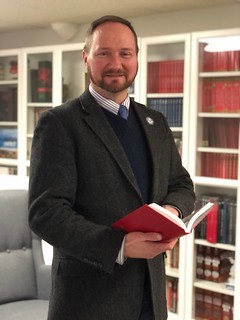 On March 23, 2021, Kentucky governor Andy Beshear commissioned Whitman Publishing's Dennis Tucker as a Kentucky Colonel in recognition of his career in book publishing, and for publicizing and promoting knowledge of the Commonwealth's status as an important subject within American numismatics.
On March 23, 2021, Kentucky governor Andy Beshear commissioned Whitman Publishing's Dennis Tucker as a Kentucky Colonel in recognition of his career in book publishing, and for publicizing and promoting knowledge of the Commonwealth's status as an important subject within American numismatics.
According to the Governor's Office, "The highest honor awarded by the Commonwealth of Kentucky is that of Kentucky Colonel." The Honorable Order of Kentucky Colonels defines the commission as "recognition of an individual's noteworthy accomplishments and outstanding service to our community, state, and nation."
A Career in Nonfiction Publishing Tucker started his career in writing and publications management in New York. In 2004 he was hired as Publisher for Whitman Publishing, LLC, one of the nation's leading publishers of nonfiction books, then headquartered in Atlanta, Georgia. Since then the company has published more than 300 books, including many standard references, relating to the art and science of numismatics (the study of coins and related objects).
DNW OFFERS SAMUEL BIRCHALL COLLECTION
Dix Noonan Webb are offering a coin collection assembled nearly a quarter millennium ago. Here's the press release. -Editor
A fascinating collection of British coins that was amassed 240 years ago by Samuel Birchall of Leeds is to be offered in a sale of Coins, Tokens and Historical Medals on Tuesday & Wednesday, May 4 & 5, 2021 by international coins, medals, banknotes and jewellery specialists Dix Noonan Webb.
The collection includes examples dating from the time of Alfred the Great and Harold II with estimates up to £2,000. Samuel Birchall (1761-1814) was a pupil of George Bewley's school in Kendal from 1773 to about 1777. The family moved to Stockport, Cheshire, in the summer of 1779, where his parents ran a calico and tea business. He married Anna Jowitt (1765-93) on 6 June 1785 and the following year moved to Leeds, where he joined his wife's family firm, John & Joseph Jowitt, woolstaplers, in which Samuel had become a partner by June 1788. Samuel Birchall is best known among present-day numismatists for his A Descriptive List of the Provincial Copper Coins or Tokens issued between the Years 1786 and 1796, an alphabetical reference to pieces in his own collection and those of a small number of other contemporaries. Apart from tokens, Samuel Birchall formed valuable collections of British gold and silver coins. Doubtless one of the sources for the coin collection was the dealer Henry Young (c. 1738-1811) of Ludgate street, London, a token issuer himself in 1794 who was followed in business by his much better-known son, Matthew Young (1770-1838), issuer of his own private token in 1798 and a collaborator with Birchall on his List, for which Henry Young was the retail outlet.
ON CONDITION, DAMAGE, AND PRICE
We don't typically discuss grading or valuation, but here's an interesting article by Allan Davisson on the issues involved in triangulating an auction estimate for pieces that exhibit flaws that can detract from market value. Not an easy task. What do readers think? -Editor
How do you value a rare coin with damage? This issue comes up fairly often in the process of cataloging coins for our sales. Damage reduces the value and makes price guides or auction history less relevant. One of the coins offered here illustrates the problem—an exceptional and undamaged portrait on a piece produced by one of the finest medallists of any era on a fresh flan but with clear damage in the field, the Thomas Simon portrait on the hammered shilling of Charles II soon after he returned from exile.
MODERN RARE COINS IN ALBUM AUCTION 40
Here's an additional press release from Stephen Album Rare Coins highlighting some modern rarities in their upcoming Auction 40. -Editor
Alongside the dramatic rise in the price of gold, modern numismatic rarities - those scarce coins minted in the last 50 years - have been emerging in the market. Two such rarities will be offered in the upcoming Stephen Album Rare Coins Auction 40 which takes place May 13-15.
"Our staff has a wide range of knowledge, and because of that, we often find rare items in collections that would have otherwise gone unnoticed. Many modern issues with very low mintages may represent a real opportunity in today's market." says Stephen Album Rare Coins CFO and Director of World Coins Paul Montz.
SELECTIONS FROM HOLABIRD MAY 2021 SALES
Here are some lots that caught my eye this week in the upcoming Holabird sale. -Editor
51 mm bronze inaugural medal w/raised bust of Harry S. Truman on Obverse. No obvious scratches or markings. Excellent cond.
THE BOOK BAZARRE
NUMISMATIC NUGGETS: MAY 2, 2021
Here's a selection of interesting or unusual items I came across in the marketplace this week. Tell us what you think of some of these. -Editor
Lot 049. Lydian Kingdom. Kroisos. Circa 564/53-550/39 BC. AR stater. Sardes mint.
Lydian Kingdom. Kroisos. Circa 564/53-550/39 BC. AR stater (19 mm, 10.60 g). Sardes mint. Confronted foreparts of lion right and bull left / Two incuse squares of unequal size. Berk 20; SNG Ashmolean 760. aVF, Lighty toned, test cut.
From the upcoming Agora Auctions sale. -Editor
To read the complete lot description, see:
Lot 049. Lydian Kingdom. Kroisos. Circa 564/53-550/39 BC. AR stater. Sardes mint.
(https://agoraauctions.com/listing/viewdetail/51043)
Other topics this week include a 1792 Half Disme, an 1848 CAL. Quarter Eagle, and a Jefferson Nickel struck on a cent planchet. -Editor
AULERCI CENOMANI GOLD STATER FOUND IN JERSEY
A metal detectorist uncovered a rare gold stater in Jersey. Thanks to Arthur Shippee for passing this along. Found via The Explorator newsletter. To subscribe to Explorator, send a blank email message to: explorator+subscribe@groups.io. -Editor
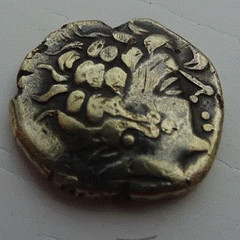 A TWO millennia-old gold coin believed to be one of the finest examples of its kind has been found by a local metal detectorist.
A TWO millennia-old gold coin believed to be one of the finest examples of its kind has been found by a local metal detectorist.
Deryck Egré found the coin – a gold stater of the Aulerci Cenomani tribe dating back to around 100 BC – in a field in St Martin, after 24 years of regular detecting.
Mr Egré said he had settled with the landowner so that the coin could remain in his collection, and that he was unlikely to sell it as ‘it is part of Jersey's heritage'.
‘I thought it was a fake,' he said. ‘I didn't think I could ever be that lucky.'
LEISER COLLECTION OF MEDIEVAL ISLAMIC COINS
There's a nice exhibit of Islamic coins at the Hallie Ford Museum of Art on Salem, OR. -Editor
"Gold of the Caliphs: Medieval Islamic Coins from the Gary Leiser Collection of the Hallie Ford Museum of Art," now on view at the Hallie Ford Museum at Willamette University in Salem, Ore., reminds us that a passion to collect can grow into a lifetime of learning, and that collections offer special, sensory insights into history. Leiser's collection of Islamic coins, the largest of its kind on the West Coast, and the most comprehensive of its kind that is readily available to students and the public, illuminates not only the rise of the Islamic faith, but also the competition between the Islamic world (and the rivalries within it) and the Byzantine Empire as well as the cultural struggles of the Mongols as they sought to maintain control over the Islamic world once they had conquered the greater part of it in 1258 CE.
IRON AGE COINS IN BRITAIN
This press release announces the Iron Age Coins in Britain (IACB) website. Many thanks to Dr Courtney Nimura for passing this along. -Editor
The School of Archaeology, University of Oxford, is pleased to announce the launch of the website: Iron Age Coins in Britain (IACB). The IACB is a digital research tool online that provides access to an edited version of the most comprehensive typology of the Iron Age coins of Britain: Ancient British Coins (ABC).
The ABC typology, published in 2010, catalogues 999 types of coins found in Britain from around the early to mid-2nd century BC through the 1st century AD. Iron Age coins provide the first written evidence from Britain and mark the end of its ‘prehistory'. These coins are mainly found in southern and eastern England and are a major source of information on society, trade, religious beliefs, and continental contacts, forming a crucial part of the archaeological record for Iron Age Britain
QUEEN'S BEASTS GOLD 10-KILO £10,000 COIN
David Pickup was the first to report this new plus-sized coin from the Royal Mint. Thanks. Here's an excerpt from the article from The Sun. -Editor
THE Royal Mint has produced a giant 10-kilo coin — its biggest in 1,135 years.
The 8in wide "masterwork" took 400 hours to perfect, including four days of polishing.
The amazing coin has already been sold, though no details were given.
However, the Mint said something of this craftsmanship would be worth six figures.
The team of master craftspeople who created the item used traditional skills alongside today's tech advances.
Engraving machines carefully cut the design on to the coin, which has a denomination of £10,000.
THE ANDOR ORAND SQUARED QUARTER
John Thomassen wrote an excellent article on the American Numismatic Society Pocket Change blog about the squared quarter. Here's an excerpt - be sure to read the complete article online. Interesting piece. -Editor
Quite often, coming across a previously unknown (to you) numismatic object can send one spiraling down a rabbit hole of investigative digging in order to uncover and learn as much as possible about said object. Such was my situation upon learning about the existence of the Squared Quarter. After seeing an image of one posted to a popular online message board, I did plenty of my own digging, and even came to learn that the American Numismatic Society has a special (and possibly unique) striking of the Squared Quarter. But first, some background:
The Squared Quarter was the brainchild of artist Andor Orand (given name Andor Carius). According to the bio on his own website dedicated to the project, Andor, born in 1942, is a German-American artist who lives and works in the Princeton, New Jersey, and New York metropolitan areas. Although he works in multiple mediums—see the Princeton University Art Museum website for a few examples of his digital artwork—Mr. Orand is perhaps most well-known for his Squared Quarter project.
NUMISMATIC SOCIETY OF MONTREAL MEDALS
Quasquicentennial medals of the Antiquarian and Numismatic Society of Montreal Medals are available from Jacob Lipson. Here's the press release. -Editor
Jacob Lipson has recently acquired a group of medals produced to commemorate the 125th anniversary of the founding of the Montreal Antiquarian and Numismatic Society. A strictly limited number of medals in silver and a small quantity in bronze are available through jacoblipsonrarecoins.com.
History
Adelard J. Boucher, Stanley C. Bagg, Joseph A. Manseau, and 17 additional charter members founded what was originally the Société Numismatique de Montreal on December 9, 1862 — the first numismatic organization in Canada and one of the first in North America. Four years later, the Society incorporated archaeological studies as part of its mandate and changed its name to the Antiquarian and Numismatic Society of Montreal. It also adopted a new seal at that time, featuring a crossed tomahawk and calumet with a Roman lamp above, a Greek coin left, the obverse of a Canadian cent right, and a beaver below.
BAUMAN COLLECTION OF CHEMICAL CURRENCY
The Science History Institute (headquartered in Philadelphia) has a nice online exhibit of paper money items related to the chemical and petroleum industry. Here are a few selections. Follow the link for more. -Editor
The Robert J. Bauman Collection contains chemical and petroleum industry currency collected by Robert J. Bauman. The contents of this collection consist of the various types of currency issued by chemical and petroleum companies in a number of countries between 1870 and 1993. Paper money and coins make up a large majority of the materials in this collection. A small number of postcards and commemorative medals are preserved in this collection as well. A small selection of paper money and a postcard have been digitized and can be found here.
1922 BANK OF PORTUGAL 500 ESCUDOS NOTE
The Greysheet published an item from Heritage Auctions about an offering of a 1922 Bank of Portugal 500 Escudos note. -Editor
One of the most famous counterfeiters did not make fake bills in the expected manner, but rather used a sophisticated scheme to have an unauthorized run of genuine notes to be printed by the central bank! Alves Reis was born to a poor family in Portugal in 1898. He did not let his modest circumstances stop him and cooked up a scheme that became known as the Portuguese Banknote Crisis.
SCRIPOMANIA AND THE MADNESS FOR SPECULATION
Dr, Benjamin Rush served as Treasurer of the United States Mint from 1797 to 1813. He was also not only a signer of the Declaration of Independence and civic leader, he was a physician, politician, social reformer, humanitarian, and educator. A forthcoming book credits Rush with a sea change on how people thought about speculative manias.
I added an image of Rush's c1818 portrait by Charles Willson Peale. -Editor
Today, there are manias in everything from bitcoin and nonfungible tokens to SPACs and meme stocks – obscure corners of the market that are getting increased attention. Whether these are the next bubbles to burst remains to be seen.
... I learned while researching my book "Speculation: A Cultural History from Aristotle to AI," which will be published in June 2021, financial speculation hasn't always been understood as a widespread craze – or even outside of individual choice.
... Smith, Washington and others still saw speculators of all types as individuals making calculated decisions, not as part of some maniacal collective or epidemic contagion.
LOOSE CHANGE: MAY 2, 2021
Here are some additional items in the media this week that may be of interest. -Editor
Here's an amusing animation video about the invention of coinage. -Editor
The first coins were produced from white gold, an alloy also called electrum. Though they are small and irregular in shape, they bear a vast range of powerful visual images, executed in startling detail and with impressive plasticity.
To watch the video, see:
Animation Movie about the Invention of Coinage
(https://www.academia.edu/video/kb2yqk)
Other topics this week include Collecting In the New Digital Age, and "Britcoins". -Editor
THE COIN AND CURRENCY CLUB
Joe Esposito passed along this website for a new company offering monthly deliveries of coins and currency from different countries around the world. Thanks. -Editor
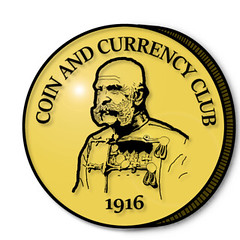 A New Country Every Month!
A New Country Every Month!
The money we use does more than just provide a means of trade: it tells a story of who we are. Whether it is of kings of a bygone era, wartime heroes, or feats of art and science, every coin and banknote has a story to tell. Coin and Currency Club brings these stories to you. Every month we deliver a coin and banknote from a different country along with informative cards full of photos, graphics, facts, and statistics of the subject nation and figures on the currency. We also include a flag sticker of the nation for you to collect! Whether you are a hobbyist looking for an engaging way to expand your collection, a traveler scoping out new destinations, or a parent looking to show your kid the beauty and vastness of the world and different cultures, Coin and Currency Club will inspire the curiosity of everyone!

